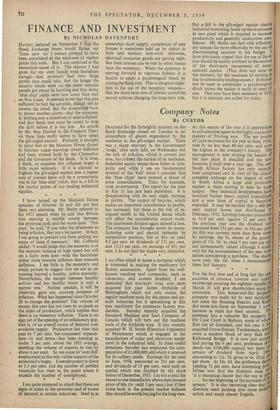FINANCE AND INVESTMENT
By NICHOLAS DAVENPORT HAVING declared on November 5 that the Stock Exchange boom would flatten out 'from now on' I cannot pretend to have been astonished at the weakness of market prices this week. But I was surprised at the immediate cause of it. The reasons 1 had given for my own hunch were humdrum enough—that investors had very large profits they could take, that the longer the security boom went on the more nervous people got about its bunting and that many 'blue chip' yields were now lower than that • on War Loan. It seemed to me that this was sufficient to halt the advance, though not to reverse the trend. But the economists have to invent another alarm—that the economy• is 'drifting into a condition of semi-inflation' and that Bank rate must be raised to stop the drift before it is too late. An article by Mr. Roy Harrod in the Financial Times on these lines really seems to have upset the gilt-edged market. Probably it brought to mind that at the Mansion House dinner in October vague warnings about inflation had been uttered both by the Chancellor and the Governor of the Bank. It is time, I think, to examine this inflation bogey a little more seriously. if it is allowed to frighten the gilt-edged market into a higher rate of interest there will be a sympathetic rise in the 'blue chip' yields, that is, a fall in the market prices of our leading industrial equities.
* *
I have turned up the Mansion House speeches of October 20 and did not find them very alarming. Mr. Butler referred to his 1953 speech when he said that Britain was steering a middle course between the primrose path and the waste land. 'This year,' he said, if you take the primroses as being inflation, they are a bit nearer. In fact, I am going to prevent you from picking too many of them if necessary.' Mr. Cobbold added: 'I would judge that the economy is at the moment running at high speed but still on a fairly even keel—with the barometer rather more towards inflation than towards deflation. I see little in the monetary and credit picture to suggest that we are as yet running beyond a healthy, active economy. Nevertheless, the margin between healthy activity and less healthy boom is only a narrow one.' Neither speaker, it will be observed, gave any concrete evidence of inflation. What has happened since October 20 to change the position? The volume 'of money this year has not risen by as much as the index of production, which implies that there is no monetary inflation. There is no sign yet of the opening of an inflationary gap, that is, of an overall excess of demand over available supply. Production has risen this year by 7 per cent. but consumers' expendi- ture—in real terms—has been running at under 3 per cent. above the 1953 average, enabling the volume of exports to rise by r. about 6 per cent. So we come to 'over-full' employment as the only visible support of the economist's bogey, Unemployment is down to 1.1 per cent, and the number of unfilled vacancies has risen to the point where it exceeds the number of unemployed.
I am quite prepared to admit that there are signs of stress in the economy and of excess Of demand in certain industries. Steel is in somewhat short supply, completion of new houses is sometimes held up by delays in bath and sanitary iron-work deliveries, electrical consumer goods are getting tight. But these stresses can be met by other means than the monetary. When the economy is moving forward in vigorous fashion it is foolish to apply a psychological shock by raising the Bank rate. That is the great objec- tion to the use of the monetary weapon— that the short-term rate of interest cannot be moved without changing the long-term rate, that a fall in the gilt-edged market checks industrial borrowing, holds up the investment in new plant which is required to increase productivity and generally undermines con- fidence. Mr. Butler can deal with inflation- ary stresses far more effectively by the use of discriminating taxation in his budget. I have previously argued that the use of Bank rate should be mainly confined to the control of the short-term movements of inter- national capital. (That does not arise at the moment, for the weakness of sterling is due to cotnmodity trading causes.) It should not be used to administer a psychological shock unless the nation is really in need of one. That may have been necessary in 1951 but it is certainly not called for today.










































 Previous page
Previous page